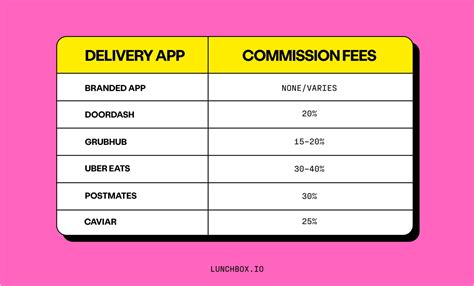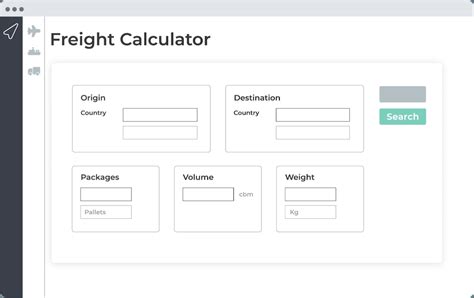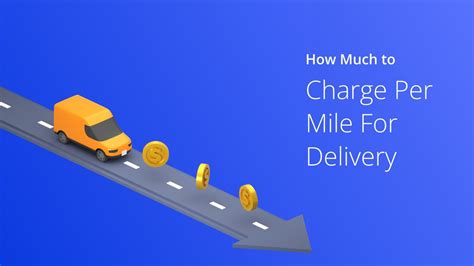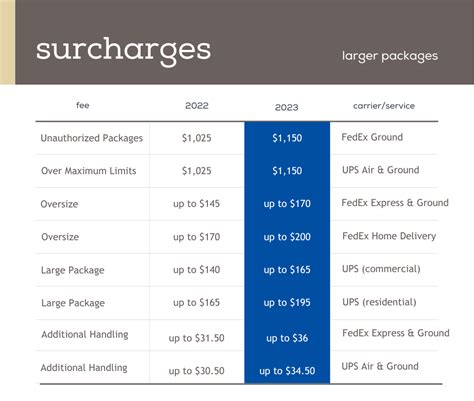How To Calculate Delivery Fee

Calculating delivery fees is a crucial aspect of the logistics and e-commerce industries. The delivery fee, often a significant component of the total cost for customers, must be carefully determined to ensure both customer satisfaction and the profitability of the business. This article aims to provide an in-depth guide on how to calculate delivery fees, exploring various factors and strategies to create an optimal pricing structure.
Understanding Delivery Fee Calculation

The calculation of delivery fees involves a delicate balance between operational costs, competitive pricing, and consumer expectations. It is a complex process influenced by numerous variables, each requiring careful consideration to ensure a fair and effective pricing strategy.
Key Factors Affecting Delivery Fee Calculation
Several key factors play a pivotal role in determining delivery fees:
- Distance and Geography: The distance between the delivery origin and destination is a primary consideration. Additionally, geographical features like mountains, rivers, or urban density can impact the complexity and cost of delivery.
- Transportation Mode: Different modes of transportation, such as road, air, or sea, have varying cost structures and capabilities. The choice of transportation mode depends on factors like delivery urgency, package size, and destination accessibility.
- Package Size and Weight: The size and weight of the package significantly influence delivery costs. Larger or heavier packages may require specialized handling and transportation, increasing the overall cost.
- Delivery Timeframe: The desired delivery timeframe, whether it’s standard, express, or same-day, affects the resources required and, consequently, the delivery fee.
- Operational Costs: These include the costs of maintaining a fleet of vehicles, fuel expenses, driver salaries, and maintenance. Additionally, there may be costs associated with warehousing, packaging materials, and insurance.
- Competitive Landscape: Understanding the pricing strategies of competitors is crucial. This involves analyzing their delivery fees, service levels, and any unique value propositions they offer.
- Customer Expectations: It’s essential to consider customer expectations and preferences. Factors like convenience, speed, and reliability can influence the delivery fee structure and customer perception.
Step-by-Step Guide to Calculating Delivery Fees

Here’s a comprehensive, step-by-step guide to help you calculate delivery fees effectively:
Step 1: Define Your Delivery Zones
The first step is to divide your service area into logical delivery zones. This could be based on geographical boundaries, population density, or even customer demographics. Each zone should represent a distinct area with similar delivery characteristics.
| Delivery Zone | Description |
|---|---|
| Zone A | Urban core with high-density population and complex traffic. |
| Zone B | Suburban areas with moderate population density and easier road access. |
| Zone C | Rural areas with low population density and longer distances between destinations. |

Step 2: Analyze Operational Costs
Calculate the operational costs associated with each delivery zone. This includes vehicle maintenance, fuel costs, driver salaries, and any other fixed or variable expenses related to the delivery process.
| Cost Category | Cost |
|---|---|
| Vehicle Maintenance | $10,000 per month |
| Fuel Expenses | $8,000 per month |
| Driver Salaries | $25,000 per month |
| Insurance and Other Overheads | $5,000 per month |
Step 3: Determine Delivery Timeframes and Pricing
Based on customer demand and business objectives, decide on the delivery timeframes you will offer, such as standard, express, or same-day delivery. Each timeframe should have a corresponding price that reflects the urgency and resources required.
| Delivery Timeframe | Price |
|---|---|
| Standard Delivery (2-3 days) | $5.99 |
| Express Delivery (Next Day) | $12.99 |
| Same-Day Delivery | $19.99 |
Step 4: Consider Package Size and Weight
Introduce additional charges for oversized or overweight packages. These charges should cover the increased transportation and handling costs associated with such packages.
| Package Category | Additional Charge |
|---|---|
| Overweight (Above 50 lbs) | $2.00 per additional pound |
| Oversized (Exceeding 30x30x30 inches) | $5.00 additional fee |
Step 5: Monitor and Adjust
Regularly monitor your delivery operations and customer feedback. This will help you identify areas where you might be overcharging or undercharging. Use this data to make informed adjustments to your delivery fee structure, ensuring it remains competitive and profitable.
Advanced Strategies for Optimizing Delivery Fees
In addition to the basic calculation methods, several advanced strategies can be employed to optimize delivery fees and enhance profitability.
Dynamic Pricing
Implement dynamic pricing, which involves adjusting delivery fees based on real-time factors like demand, weather conditions, traffic congestion, or even competitor pricing. This strategy allows for maximum flexibility and the ability to respond quickly to changing market dynamics.
Bundle Services
Offer bundled services, such as packaging and delivery, to create a more comprehensive and attractive offering. This can help increase the perceived value of your services and justify higher delivery fees.
Partner with Carriers
Explore partnerships with established carriers or logistics companies. Such partnerships can provide access to their infrastructure, expertise, and economies of scale, potentially reducing your operational costs and allowing for more competitive delivery fees.
Utilize Technology
Leverage technology to streamline delivery operations and reduce costs. This can include route optimization software, real-time tracking systems, and automated scheduling tools. These technologies can enhance efficiency, reduce delivery times, and lower operational expenses.
Future Implications and Trends
The landscape of delivery fees is evolving rapidly, influenced by technological advancements, changing consumer preferences, and the growing importance of sustainability.
Sustainability and Environmental Concerns
With increasing environmental awareness, there is a growing trend towards sustainable delivery practices. This includes the use of electric vehicles, optimized routing to reduce fuel consumption, and even carbon offsetting. Such initiatives may add a small surcharge to delivery fees but are increasingly viewed as a necessary step towards environmental responsibility.
The Rise of On-Demand Delivery
The demand for on-demand delivery services, especially in urban areas, is rising rapidly. This trend is driven by consumers’ desire for immediate gratification and convenience. On-demand delivery often comes with a premium price tag, reflecting the urgency and specialized nature of the service.
Data-Driven Decision Making
Advanced analytics and data-driven decision-making are becoming integral to the logistics industry. By leveraging data on delivery routes, traffic patterns, and customer behavior, companies can optimize their delivery operations, reduce costs, and offer more competitive pricing.
How often should I review and adjust my delivery fee structure?
+
It’s recommended to review your delivery fee structure at least annually, but more frequent reviews, such as every quarter, can be beneficial. This ensures your pricing remains competitive and aligned with changing market conditions.
What are some best practices for communicating delivery fees to customers?
+
Transparency is key. Clearly display delivery fees during the checkout process and provide explanations for any additional charges. Offer multiple payment options, including options to waive delivery fees for specific purchase amounts or through loyalty programs.
How can I handle unexpected increases in operational costs, such as fuel price spikes?
+
It’s important to build a certain degree of flexibility into your delivery fee structure. Regularly monitor operational costs and make adjustments as needed. In cases of significant cost increases, consider temporary surcharges or adjustments to your delivery timeframes and pricing.



